Gräsö Land types
The Gräsö landscape is a combination of a great variety of biotopes.
The cultivated farmland forms little islands in the otherwise forest-dominated landscape. Some of the more prominent land types are described here:
Coastal meadows
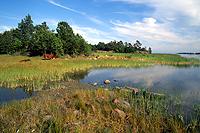
Along the shores of Gräsö there are coastal meadows. During the Middle Ages these were a very important resource and a big reason for colonising the islands from the mainland. Areas that were coastal meadows then are by now arable or pasture due to the rapid uplift of the land - 0.6 m per100 years. Today’s meadows were formed more recently.
Some of the present day meadows are still grazed. They are an important resting site for migrating geese and waders, such as Lesser White-fronted Goose (Anser erythropus), Barnacle Goose (Branta bernicla), Shoveler (Anas clypeata), Garganey (Anas querquedula), Dunlin (Calidris alpina), Spotted Redshank (Tringa erythropus) and Ruff (Philomachus pugnax). Typical plants are Blue Moorgrass (Sesleria caerulea); Common Arrow-grass (Triglochin maritima); Sea milkwort (Glaux maritima); Bird´s –eye primrose (Primula farinosa) and Grass-of-Parnassus (Parnassia palustris). Gentians and several types of orchids are also fairly common.
Pastures
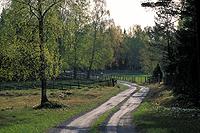
The grazings are often situated close to the farmsteads. Some of the pastures are sparsely forested whilst others have no trees.
Ash (Fraxinus excelsior), whitebeam (Sorbus intermedia), maple (Acer platanoides), crab apple (Malus sylvestris), rowan (Sorbus acuparia) and willow (Salix spp.) dominate the wooded areas. Some of the open pasture is turning gradually into forest. Bushes such as juniper (Juniperus communis), dog rose (Rosa spp.), hazel, fly honeysuckle (Lonicera xylosteum) and Sea Buckthorn (Hippophae rhamnoides) are common. The ground is very stony and the bedrock is often exposed, resulting in a wealth of microhabitats. One can also still find small areas of former arable land which were cleared of stones; some are as small as 10 square meters. Dropwort (Filipendula vulgaris), Bloody cranesbill (Geranium sanguinium), sticky catchfly (Lychnis viscaria) and swallow-wort (Vincetoxicum hirundinaria) are common. In the pastures, often in conjunction with areas of bare rock, there are large numbers of pollared trees, mainly ash, whitebeam and birches (Betula spp.).
Meadows
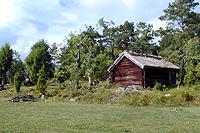
Practically all areas of postglacial clay or sandy soils on Gräsö were used as traditional hay meadows. The meadows dominated the farming landscape for centuries – the area of arable was small in comparison.
Of all the different land types, a meadow supports the highest number of species. Plants which neither like to be shaded by long grass and trees nor to be grazed hard by animals thrive here. Species such as moon carrot (Seseli libanotis), Irish fleabane (Inula salicina), crested cow-wheat (Melampyrum cristatum), many orchids and a significant number of butterfly species have diminished in the landscape as the traditional hay meadows disappeared. On Gräsö many of these meadows have been ploughed and cultivated, forested or turned in to pasture. One can still find a few meadows that are looked after in the traditional way and also remnants of wood meadows with pollared trees.
Pine forests on rocky ground
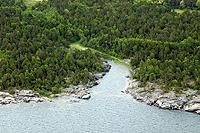
These forests grow on flat rocks and cliff faces. The pine trees (Pinus sylvestris) grow very sparsely and their roots find there way down through cracks in the cliffs and boulders. The trees grow very slowly and the ground is often covered with lichens such asreindeer moss. Where the soil is somewhat deeper shrubs such as heather (Calluna vulgaris), cowberry (Vaccinium vitis-idaea) and bilberry (Vaccinium myrtillus) grow.
In the ancient sun streamed trees there is a rich population of beetles, among others the beautiful jewel beetles (Buprestidae), which live on the coarse old branches, under the bark of the stems or on exposed roots. Many of these beetles are threatened by extinction due to modern forestry practice and the disappearance of the forest grazing areas. The longhorn beetle (Nothorina punctata) is another very threatened species that still lives in the gnarly old pine trees of Gräsö.
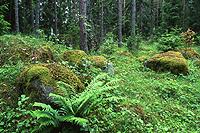
Pine tree forests mixed with ash, whitebeam, Norway spruce (Picea abies), birch, aspen, rowan and willow, growing on limestone moraine is often rich in herb and grass vegetation. Several bushes such as hazel (Corylus avellana),guelder-rose (Viburnum opulus), Fly Honeysuckle (Lonicera xylosteum) and Alpine Currant (Ribes alpinum), especially in areas where the pine trees don’t shade the ground completely, are common here. There is also a rich fungi flora, with many rare species. On Gräsö this type of pine forest on grassland is very common and most of these areas used to be wood pastures. As the grazing ceased the numbers of species in the woods diminished.
Arable fields
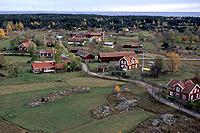
Cultivated fields on Gräsö are mainly used for forage production. There has never been much arable cropping as such on the island. Todays cultivated fields correspond very well with the location of the traditional hay meadows as they were 300 years ago. The average size of a field is 0.5 – 1.0 ha. A prominent feature of the fields is the open ditches. Some of the fields have not been ploughed or fertilized for many years and have started to regain their former flora. This is most noticeable on the sandy soils.
© Photos Gräsö: Sven-Olov Borgegård, Maria Hoflin, Ola Jennersten, Upplandsstiftelsen


